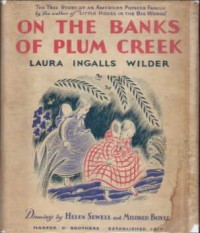The little cloud was glittering gold

On the Banks of Plum Creek
by Laura Ingalls Wilder
Finally a Little House book that didn’t upset me politically and had plenty of story and good writing! This is the fourth book in the series, so this may contain spoilers if you are that rare breed like me and haven’t read the Little House books.
The Ingalls family have moved on to Minnesota, buying land from a Mr Hanson who wants to travel out west. Initially, they live in Hanson’s small dugout home, quite literally built into the banks of the creek, but Pa is certain that once he grows a good crop of wheat they can afford to build themselves a proper house and have all the treats they could dream of.
It’s clear from early on that Pa is setting himself up for a fall, especially when he borrows money in anticipation of the wheat crop, but I think that just shows how Wilder had developed as a writer by this point. Again, Laura’s age is not quite accurate to her real life as she is depicted as 7–9 years old rather than 4–5, which would actually make more sense of some details in the story. Laura and her big sister Mary are sent to school for the first time in their lives (they are only two miles from a small town) and while Mary can read and write already (having submitted to lessons from Ma), Laura can’t yet do either.
This really did have the best qualities of the previous two books. There are lovely descriptions of the landscape, both in good times and bad, there are interesting details about farming and housebuilding, there are Laura’s moments of naughtiness (Wilder has set herself up from book 1 as the wild child and Mary as the goodie goodie) and a stark contrast between the highs and lows that the family goes through. There are genuinely life-threatening times, standing beside Laura’s petty conflict with another girl at school.
“The sky was very faintly pink, then it was pinker. The colour went higher up in the sky. It grew brighter and deeper. It blazed like fire, and suddenly the little cloud was glittering gold. In the centre of the blazing colour, on the flat edge of the earth, a tiny sliver of sun appeared. It was a short streak of white fire. Suddenly the whole sun bounded up, round and huge, far bigger than the ordinary sun and throbbing with so much light that its roundness almost burst.”
Published 1937 by Harper and Brothers.
Source: Google Books.